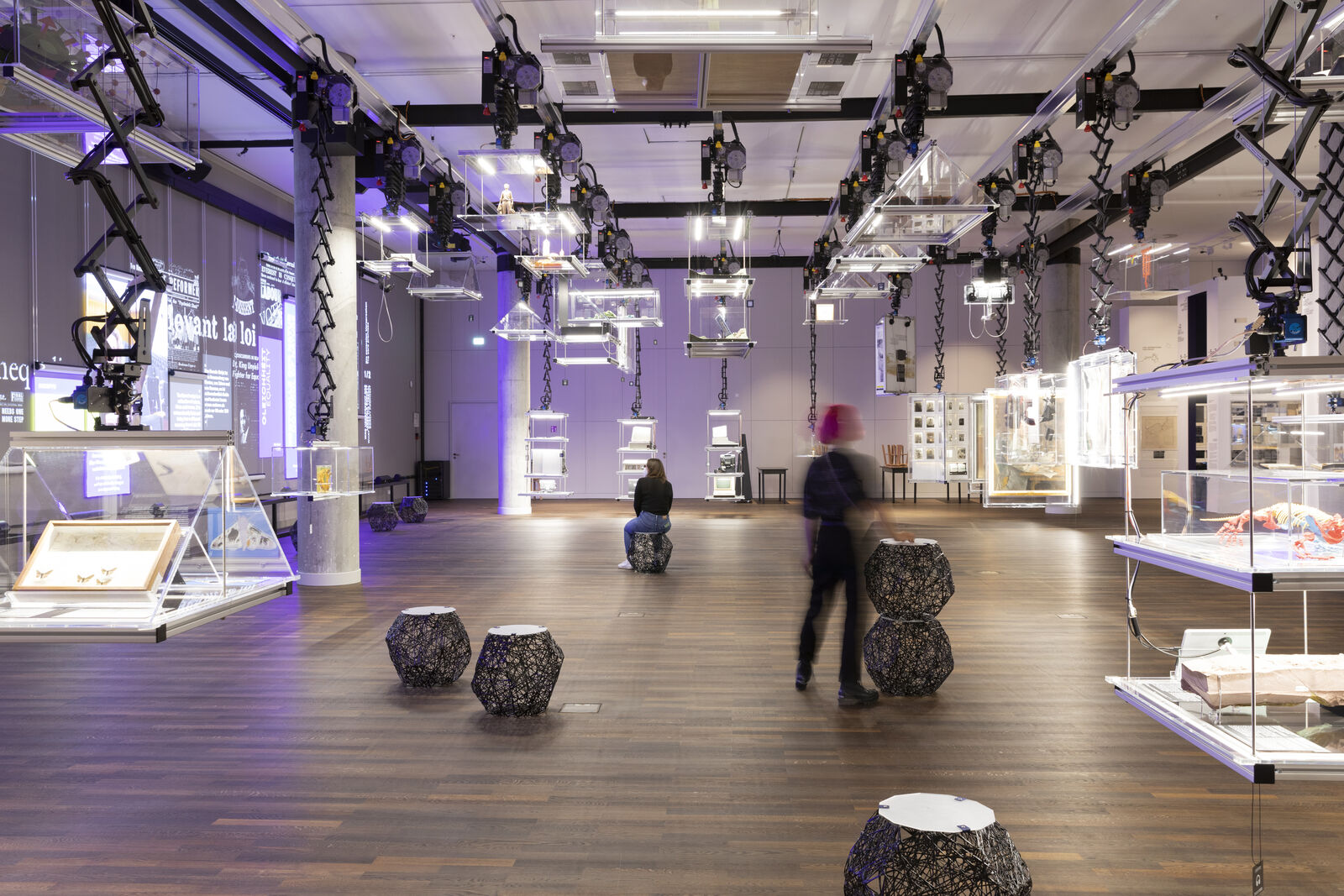Humboldt Lab
The Humboldt Lab in the Humboldt Forum presents research by the Berlin Clusters of Excellence, the Berlin University Alliance and other cutting-edge institutes and faculties at the Humboldt-Universität. It aims to become a living workshop of ideas where top-level research enters into a dialogue with the public on pressing issues of our time.
Visitors see for themselves the significance of scientific search and cognitive processes, and interdisciplinary work. They experience how scientific research affects everyone. On about 1,000 sqm, the Humboldt Lab provides an insight into the variety and relevance of science. It is institutionally located at the Hermann von Helmholtz-Zentrum für Kulturtechnik, a central institute of the Humboldt-Universität zu Berlin.
The Humboldt Labor’s inaugural exhibition »After Nature,« which finally opens its doors to the public on July 20th, 2021, brings together and relates a wide range of research approaches to the interactions between climate change and biodiversity loss and the global challenges to democratic principles of order in the form of a modern Wunderkammer.
The Cluster of Excellence »Matters of Activity« contributes to this discourse with the following exhibits, opening up diverse insights into its research projects.
Active Curtain Project
The »Active Curtain Project« is an ongoing experimental setting by the Cluster of Excellence »Matters of Activity« which brings together various disciplinary skills for the rediscovery of adaptive textile techniques – crafted and grown – in the quest to create an active basis for our relationship with our Umwelt. Woven into a curtain in the entrance area of the Humboldt Lab, various interactive and translucent elements made of bacterially generated and plant cellulose react to the room climate. The naturally generated matter moves, connects, swells and twists – without any conventional mechanical devices. The scale and the hidden speed of their activity are shown in images and films.
Researchers
Bastian Beyer, PhD
Skander Hathroubi, PhD
Prof. Dr. Regine Hengge
Natalija Miodragović
Iva Rešetar
Prof. Christiane Sauer
Nelli Singer
Daniel Suarez
Below you can find an interview with Bastian Beyer and Skander Hathroubi showing the making of parts of the »Active Curtain Project«.
Adaptive Digital Twin
The project Adaptive Digital Twin of the »Matters of Activity« Cluster of Excellence works on generating adaptive holographic models of the human brain. These models provide help for the clinical practice, for example during the preparation surgeries. They function like an online map service by providing orientation and guidelines on the virtual map of the brain. Physicians could visualize the position of a tumor and simulate the potential effect of its growth. A researcher will work temporarily at the exhibition element.
Find out more about the project here.
Researchers
Dr. Lucius S. Fekonja
Denny Chakkalakal (Charité)
Darius Mewes (Charité)
Felix Rasehorn
PhD Jacques-Donald Tournier (King’s College London)
PD Dr. Thomas Picht
Cluster Introduction Video
At the Cluster, researchers from 40 disciplines investigate the activity of materials. Objects and materials are to be rethought: as changeable and recyclable building materials. In order to better understand their properties, the members of the Cluster investigate exemplary cultural and natural techniques such as weaving, cutting and filtering. These techniques occur in and with materials in a variety of ways, such as physically, biologically, and artisanally. The practices and processes tell us a lot about the material, its productive power or the environment.
Along with all other Berlin Clusters of Excellence, »Matters of Activity« presents itself with a video in the Humboldt Lab.
Orobates Pabsti
»Orobates pabsti« lived 300 million years ago. Using a 3D model of its skeleton, the Humboldt Lab shows what modern cutting-edge research looks like. The researchers reconstructed the locomotion of the prehistoric dinosaur. A yellow spine, a red head and two blue feet: in contrast to the pale dinosaur skeletons from museums, the model of »Orobates pabsti« glows in several colors and there's a reason for that – The model, reminiscent of a reptile, symbolizes how scientists work, explains John Nyakatura, assistant professor of morphology (zoology) and history of forms at HU. »The mounted skeleton illustrates our approach to reconstruction and shows that we deal transparently with uncertainties,« says the biologist, who studied the dinosaur's locomotion together with EPFL's »Biorobotics Laboratory« in Switzerland. The work was done in MoA's predecessor Cluster »Image Knowledge Gestaltung«.
Researcher
Stone Web
»Stone Web« was developed by designers Idalene Rapp and Natascha Unger, whose aim is to produce multi-purpose, lightweight modules for interior design. The base material used for the structures is basalt. Melted down and extruded into filaments, it transforms into a lightweight construction material. The combination of material and design makes these resin-reinforced objects solid and robust. The exhibition sees the material processed into seating modules, which can also be connected to form larger spatial structures. They weigh less than 1 kg and have a load-bearing capacity of up to 720 kg. »Stone Web« was created under the supervision of Prof. Christiane Sauer in the Textile and Surface Design department of the weißensee school of art and design berlin as part of the Cluster »Matters of Activity. Image Space Material«.
Designers
Idalene Rapp (weißensee school of art and design berlin)
Natascha Unger (weißensee school of art and design berlin)
Christiane Sauer















